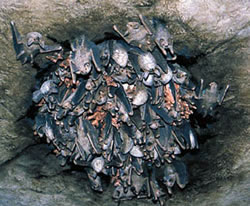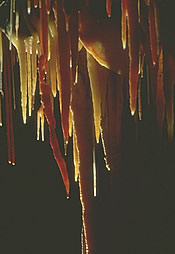 |
|
Bats
in the cave. ©1999, AZ State Parks
|
Travel
opportunities are abundant and easy to find in Tucson, Arizona. But if you are
looking for a unique adventure that will let you escape into a cool, underground
wonderland, check out Kartchner Caverns State Park in Benson, Arizon, just 50
miles southeast of Tucson.
This
small town of Benson boasts one of the top ten mineral rich caves in America.
Kartchner was discovered in 1974 by spelunkers Gary Tenen and Randy Tufts. Smelling
bat guano in the breeze, they followed the smell to its source, a hole in the
Whetstone Mountains. Squeezing into a small opening, they stumbled upon the fantastic
caverns, which they kept a secret for 14 years. Kartchner was opened to the public
in November of 1999, after many years of work to ensure a safe, quality experience
as well as a protective environment for the cave formations.
The
tour begins with an electric tram ride across the desert to the opening of the
cave. Once there, visitors enter through airtight refrigerator doors that keep
the cave at a constant 68 degrees, with 99% humidity. The tunnel leading down
to the entrance allows body temperatures to cool so not as much heat enters the
cave. With temperatures outside often reaching over 100 degrees, this is an important
precaution. Visitors also pass through an air curtain that blows lint from their
clothing. The Arizona State Parks Department has used these cutting-edge cave
development techniques to protect this "live" limestone cave's unique
micro-environment.
 |
|
Rock
formations in the cave.
©1999, AZ State Parks
|
Once
inside, soft lighting reveals a fantastic variety of stalactites and stalagmites,
many of which are still forming. Among the unique attractions is an extremely
thin soda straw stalactite, hanging 21 feet 2 inches down from the cave's ceiling
When
I toured the caverns, I saw not only "cave bacon," but also the "fried
egg" formation. This unique rock looked like yellow egg yolk was oozing out
of it. Our tour guide pointed out "cave popcorn." All these formations
made me a little anxious for lunch, but the best part of the tour was yet to come.
We entered
a big room where the massive Kubla Kahn column towered before me, 58 feet tall.
This is a stalactite and stalagmite joined together, forming a thick, multicolor
column. Everyone fell completely silent. In that silence I could imagine what
Randy Tufts or Gary Tenen felt like when they became the first people on earth
to view this underground wonder.
Thanks to their efforts, countless visitors will
be able to share this experience for many years.
The
Throne Room and Rotunda Room on the upper level are currently open for tours.
The lower level is still under development.
When
visiting Kartchner Caverns, make reservations. A two-month wait for
reservations is not unusual. The park staff recommends visitors plan for at least
three hours at the park. There is an adjacent Discovery Center, as well as a 2-mile
moderate-rated interpretive nature trail, a hummingbird trail, and trail access
to Coronado National Forest.
For more information, visit Kartchner Caverns State Park's website.